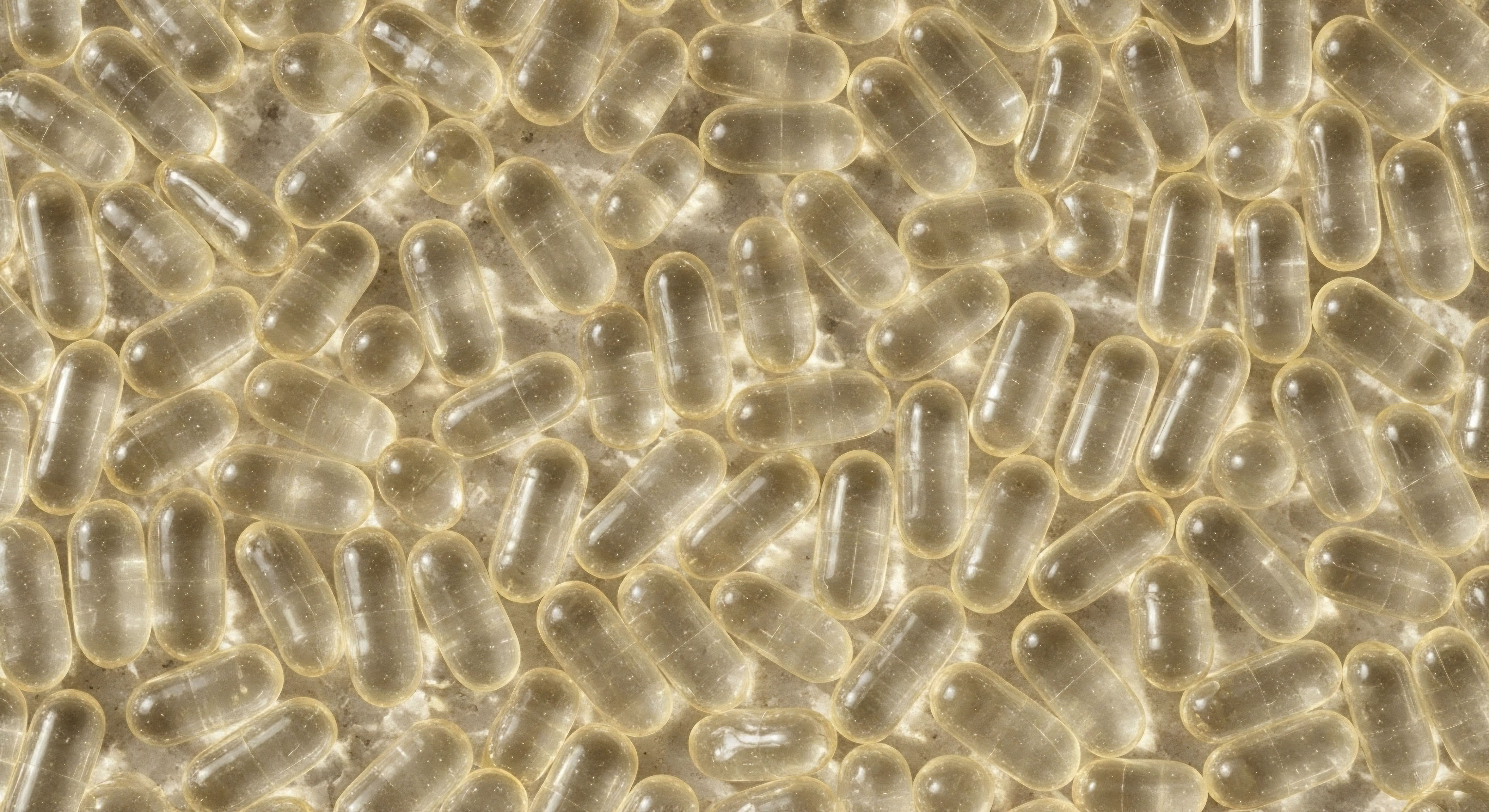

Fundamentals
Have you ever experienced a subtle shift in your vitality, a quiet erosion of the energy and clarity that once defined your days? Perhaps you find yourself grappling with unexplained fatigue, persistent mood fluctuations, or a recalcitrant body composition that resists your best efforts.
These sensations, while often dismissed as inevitable aspects of aging or daily stress, frequently signal a deeper conversation occurring within your biological systems. Your body communicates through a sophisticated network of chemical messengers, and when these signals become muddled, the impact on your lived experience can be profound.
Understanding your internal chemistry represents a powerful step toward reclaiming optimal function. Hormones, those potent signaling molecules, orchestrate virtually every physiological process, from your sleep patterns and mood stability to your metabolic rate and physical resilience. When their delicate balance is disrupted, the consequences ripple across your entire being, manifesting as the very symptoms you might be experiencing.
Hormonal balance represents a dynamic equilibrium essential for maintaining overall physiological well-being and vitality.
The concept of personalized wellness protocols, particularly those involving hormonal optimization, aims to restore this equilibrium. Genetically guided hormone therapy takes this personalization a step further, seeking to tailor interventions based on your unique genetic blueprint. This approach acknowledges that each individual processes and responds to hormones differently, influenced by variations in genes that govern hormone synthesis, metabolism, and receptor sensitivity. The goal is to provide precise, individualized support, moving beyond a one-size-fits-all approach to biochemical recalibration.
As we consider any long-term intervention, especially those influencing fundamental biological systems, a thorough understanding of safety considerations becomes paramount. The body possesses intricate feedback loops designed to maintain homeostasis, a state of internal stability. Introducing exogenous hormones or modulating endogenous production requires careful navigation of these inherent regulatory mechanisms. Our exploration begins by recognizing the body’s innate intelligence and the importance of supporting, rather than overriding, its natural rhythms.

What Is Hormonal Homeostasis?
The human body maintains a remarkable internal stability, a state known as homeostasis. This dynamic process involves constant adjustments to physiological parameters, including temperature, blood sugar, and hormone levels. The endocrine system, a collection of glands that produce and secrete hormones, plays a central role in this regulatory dance. Hormones act like messengers, traveling through the bloodstream to target cells and tissues, eliciting specific responses.
Consider the example of thyroid hormones, which regulate metabolism. When thyroid hormone levels drop, the hypothalamus in the brain releases thyrotropin-releasing hormone (TRH), which signals the pituitary gland to release thyroid-stimulating hormone (TSH). TSH then prompts the thyroid gland to produce more thyroid hormones. As levels rise, the hypothalamus and pituitary reduce their output, creating a self-regulating feedback loop. This intricate system ensures that hormone concentrations remain within optimal ranges, preventing both deficiencies and excesses.

Personalized Wellness and Genetic Influence
Traditional hormone therapy often relies on population-level data and standardized dosing. However, individual responses to hormonal interventions can vary significantly. This variability stems, in part, from genetic differences. Your genes influence how your body produces, transports, metabolizes, and responds to hormones. For instance, variations in genes encoding enzymes involved in hormone breakdown can affect how quickly a particular hormone is cleared from your system, influencing its effective dose and potential for accumulation.
Genetically guided hormone therapy seeks to identify these individual predispositions. By analyzing specific genetic markers, practitioners can gain insights into an individual’s unique biochemical pathways. This information then informs the selection of specific hormonal agents, their dosages, and the timing of administration, aiming to optimize therapeutic outcomes while minimizing potential adverse effects. The promise lies in a more precise and predictable approach to endocrine system support.


Intermediate
Moving beyond the foundational understanding of hormonal balance, we now consider the specific clinical protocols employed in personalized wellness, particularly those involving targeted hormonal optimization. These protocols are designed to address specific physiological needs, often arising from age-related declines or other endocrine system imbalances. The “how” and “why” of these therapies are rooted in a deep understanding of biochemical pathways and receptor interactions.
Testosterone replacement therapy, for instance, aims to restore physiological testosterone levels in individuals experiencing symptoms of deficiency. For men, this often involves weekly intramuscular injections of Testosterone Cypionate. This exogenous testosterone helps alleviate symptoms such as reduced energy, diminished libido, and changes in body composition.
However, the body’s natural production of testosterone can be suppressed by external administration. To mitigate this, protocols frequently include medications like Gonadorelin, administered subcutaneously twice weekly. Gonadorelin stimulates the pituitary gland to release luteinizing hormone (LH) and follicle-stimulating hormone (FSH), thereby supporting endogenous testosterone production and preserving testicular function, which is particularly relevant for maintaining fertility.
Careful monitoring of blood parameters remains essential for optimizing therapeutic outcomes and ensuring patient safety during hormonal interventions.
Another consideration in male hormonal optimization is the conversion of testosterone to estrogen, a process mediated by the enzyme aromatase. Elevated estrogen levels in men can lead to undesirable effects such as gynecomastia or fluid retention. To counteract this, an aromatase inhibitor like Anastrozole is often prescribed, typically as an oral tablet twice weekly, to block this conversion. Additional medications, such as Enclomiphene, may also be incorporated to further support LH and FSH levels, promoting natural testosterone synthesis.

Testosterone Optimization for Women
Hormonal balance for women, particularly during peri-menopause and post-menopause, also benefits from targeted support. Women can experience symptoms like irregular cycles, mood changes, hot flashes, and reduced libido due to declining hormone levels. Low-dose testosterone therapy, often administered as Testosterone Cypionate via subcutaneous injection (typically 10 ∞ 20 units weekly), can significantly alleviate these symptoms. This approach aims to restore physiological testosterone levels, which play a vital role in female sexual function, mood, and bone density.
Progesterone, a key hormone in female reproductive health, is prescribed based on menopausal status and individual needs. It helps balance estrogen’s effects and supports uterine health. Some women may also opt for pellet therapy, which involves the subcutaneous insertion of long-acting testosterone pellets. When appropriate, Anastrozole may be included in female protocols to manage estrogen levels, particularly in cases where testosterone conversion is a concern.

Growth Hormone Peptide Therapy
Beyond traditional hormone replacement, peptide therapies offer another avenue for biochemical recalibration. Growth hormone peptides, such as Sermorelin, Ipamorelin / CJC-1295, Tesamorelin, Hexarelin, and MK-677, are utilized by active adults and athletes seeking benefits like improved body composition, enhanced recovery, and better sleep quality.
These peptides work by stimulating the body’s natural production and release of growth hormone, rather than directly introducing exogenous growth hormone. This approach often leads to a more physiological release pattern, potentially mitigating some of the side effects associated with direct growth hormone administration.
For instance, Sermorelin and Ipamorelin / CJC-1295 are growth hormone-releasing peptides (GHRPs) and growth hormone-releasing hormone (GHRH) analogs, respectively, that act on the pituitary gland to promote the pulsatile release of growth hormone. Tesamorelin specifically targets visceral fat reduction, while Hexarelin and MK-677 also stimulate growth hormone secretion through different mechanisms. Safety considerations for these peptides include monitoring for potential effects on glucose metabolism, as growth hormone can influence insulin sensitivity.

Monitoring and Safety Protocols
Long-term safety in genetically guided hormone therapy relies heavily on rigorous monitoring and individualized adjustments. Regular blood work provides critical insights into hormone levels, metabolic markers, and overall health status.
- Hormone Levels ∞ Measuring testosterone, estrogen, progesterone, LH, FSH, and thyroid hormones ensures therapeutic ranges are maintained.
- Complete Blood Count (CBC) ∞ Monitoring red blood cell count is important, especially with testosterone therapy, due to the potential for erythrocytosis (increased red blood cell mass).
- Lipid Panel ∞ Assessing cholesterol and triglyceride levels helps evaluate cardiovascular health.
- Liver and Kidney Function Tests ∞ These tests ensure the organs responsible for metabolizing and eliminating medications are functioning optimally.
- Prostate Specific Antigen (PSA) ∞ For men on TRT, regular PSA screening is essential to monitor prostate health.
- Bone Mineral Density (BMD) ∞ Baseline and periodic BMD scans can assess skeletal health, particularly relevant for women.
- Glucose Metabolism ∞ Fasting glucose and HbA1c levels are monitored, especially with growth hormone peptide therapy, to assess insulin sensitivity.
Genetic insights can further refine these monitoring protocols. For example, individuals with genetic predispositions to higher aromatase activity might require more frequent estrogen monitoring or a higher initial dose of an aromatase inhibitor. Similarly, genetic variations affecting insulin signaling could prompt more vigilant glucose monitoring when using growth hormone-stimulating peptides. This proactive, data-driven approach allows for timely adjustments, ensuring the ongoing safety and efficacy of the therapeutic regimen.
| Agent | Primary Use | Potential Safety Considerations | Monitoring Parameters |
|---|---|---|---|
| Testosterone Cypionate | Male/Female HRT | Erythrocytosis, lipid changes, prostate health (men), acne, hair loss | Testosterone, Estrogen, CBC, PSA (men), Lipids |
| Anastrozole | Estrogen management | Joint pain, bone density changes, lipid changes | Estrogen, Bone Mineral Density, Lipids |
| Gonadorelin | Fertility/Endogenous production support | Headache, flushing, injection site reactions | LH, FSH, Testosterone |
| Sermorelin / Ipamorelin / CJC-1295 | Growth hormone stimulation | Glucose intolerance, fluid retention, carpal tunnel syndrome | IGF-1, Fasting Glucose, HbA1c |
| Progesterone | Female HRT | Mood changes, breast tenderness, fluid retention | Progesterone, Estrogen |


Academic
Our exploration now deepens into the intricate scientific underpinnings of long-term genetically guided hormone therapy, moving beyond clinical applications to the molecular and systemic interactions that dictate safety and efficacy. The endocrine system operates as a highly interconnected network, where alterations in one hormonal axis inevitably influence others. Understanding this complex interplay, particularly through the lens of systems biology, is paramount for optimizing patient well-being over extended periods.
The Hypothalamic-Pituitary-Gonadal (HPG) axis serves as a prime example of this interconnectedness. The hypothalamus releases gonadotropin-releasing hormone (GnRH), which stimulates the pituitary to secrete LH and FSH. These gonadotropins then act on the gonads (testes in men, ovaries in women) to produce sex hormones like testosterone and estrogen.
Exogenous hormone administration, such as testosterone replacement therapy, can suppress the natural feedback mechanisms of the HPG axis, leading to reduced endogenous hormone production. This suppression is a key consideration, particularly for fertility, which is why agents like Gonadorelin are used to maintain pulsatile GnRH signaling and support testicular function.
Pharmacogenomics offers a powerful lens through which to predict individual responses to hormone therapy, enhancing safety and personalization.
Pharmacogenomics, the study of how genes affect a person’s response to drugs, offers a powerful lens for predicting individual responses and potential adverse effects in hormone therapy. Genetic variations in enzymes responsible for hormone metabolism, such as CYP19A1 (aromatase) or SRD5A2 (5-alpha reductase), can significantly alter the bioavailability and activity of administered hormones.
For instance, individuals with specific polymorphisms in CYP19A1 might exhibit higher aromatase activity, leading to increased conversion of testosterone to estrogen. This genetic predisposition necessitates a more aggressive approach to estrogen management with aromatase inhibitors, or a different dosing strategy, to mitigate risks like gynecomastia or cardiovascular concerns.

Cardiovascular and Metabolic Considerations
Long-term hormonal optimization protocols require rigorous attention to cardiovascular and metabolic health markers. Testosterone therapy, while generally beneficial for metabolic parameters in hypogonadal men, can influence lipid profiles and hematocrit. An increase in hematocrit (the proportion of red blood cells in blood) can elevate blood viscosity, potentially increasing the risk of thrombotic events.
Regular monitoring of complete blood count (CBC) and judicious phlebotomy, if necessary, become critical safety measures. The impact on lipid profiles, including HDL and LDL cholesterol, also warrants close observation, as some studies suggest varying effects depending on the mode of administration and individual metabolic status.
Growth hormone-stimulating peptides, while offering significant benefits, require careful monitoring of glucose metabolism. Growth hormone itself is a counter-regulatory hormone to insulin, meaning it can raise blood glucose levels. Individuals with pre-existing insulin resistance or genetic predispositions to type 2 diabetes may experience exacerbated glucose dysregulation.
Monitoring fasting glucose, HbA1c, and insulin sensitivity markers becomes essential to prevent the development or worsening of metabolic syndrome. The precise mechanism involves growth hormone’s ability to reduce insulin-stimulated glucose uptake in peripheral tissues and increase hepatic glucose output.

Oncological Surveillance and Genetic Risk
A significant long-term safety consideration involves oncological surveillance, particularly concerning prostate health in men and breast health in women. While the relationship between testosterone therapy and prostate cancer remains a topic of ongoing research, current evidence suggests that testosterone replacement does not increase the risk of prostate cancer in men without pre-existing disease.
However, it can accelerate the growth of pre-existing, undiagnosed prostate cancer. Therefore, diligent Prostate Specific Antigen (PSA) screening and digital rectal examinations (DRE) are standard practice for men on TRT. Genetic factors, such as mutations in genes like BRCA1/2 or family history, can further inform the risk assessment and screening frequency.
For women, the interplay of estrogen, progesterone, and testosterone in breast tissue is complex. While low-dose testosterone therapy in women is generally considered safe, and some studies even suggest a protective effect against breast cancer, individualized risk assessment is crucial. This includes considering personal and family history of breast cancer, genetic predispositions (e.g.
BRCA mutations), and regular mammographic surveillance. The precise balance of hormones, guided by genetic insights into receptor sensitivity and metabolic pathways, aims to minimize any potential proliferative effects on breast tissue.

How Do Genetic Variations Influence Hormone Metabolism?
Genetic variations, known as polymorphisms, can significantly influence how an individual metabolizes and responds to hormones. These variations can affect:
- Hormone Synthesis ∞ Genes encoding enzymes involved in the production of hormones (e.g. steroidogenic enzymes).
- Hormone Transport ∞ Genes affecting carrier proteins like Sex Hormone Binding Globulin (SHBG), which influence hormone bioavailability.
- Hormone Receptors ∞ Variations in genes for androgen receptors (AR), estrogen receptors (ER), or growth hormone receptors (GHR) can alter cellular sensitivity to hormones, meaning the same hormone level might elicit a different biological response in different individuals.
- Hormone Metabolism and Clearance ∞ Genes for enzymes like cytochrome P450 (CYP) enzymes (e.g. CYP3A4, CYP2D6) or uridine diphosphate glucuronosyltransferases (UGTs) dictate how quickly hormones are broken down and eliminated from the body.
For example, a common polymorphism in the androgen receptor (AR) gene involves a variable number of CAG repeats. Shorter CAG repeat lengths are associated with increased AR sensitivity, meaning individuals with these variants might respond more robustly to lower doses of testosterone.
Conversely, longer CAG repeats can lead to reduced AR sensitivity, potentially requiring higher doses or different therapeutic strategies to achieve desired effects. Integrating such genetic information allows for a truly personalized approach, moving beyond empirical dosing to a genetically informed strategy that anticipates individual metabolic and receptor responses, thereby enhancing safety and optimizing outcomes.
| Gene/Polymorphism | Associated Enzyme/Receptor | Implication for Hormone Therapy | Safety Consideration |
|---|---|---|---|
| CYP19A1 (rs700518) | Aromatase | Influences testosterone to estrogen conversion rate | Estrogen management, gynecomastia, cardiovascular risk |
| AR (CAG repeats) | Androgen Receptor | Affects androgen receptor sensitivity | Dosing requirements, response variability, potential for side effects |
| SRD5A2 (V89L) | 5-alpha Reductase | Impacts testosterone to DHT conversion | Androgenic side effects (acne, hair loss), prostate health |
| MTHFR (C677T, A1298C) | Methylenetetrahydrofolate Reductase | Affects methylation pathways, influencing hormone detoxification | Overall metabolic health, detoxification capacity, cardiovascular risk |
| FTO (rs9939609) | Fat Mass and Obesity Associated Gene | Associated with obesity and metabolic syndrome risk | Glucose metabolism, insulin sensitivity, weight management in therapy |

References
- Mooradian, Arshag D. et al. “Biological actions of androgens.” Endocrine Reviews, vol. 8, no. 1, 1987, pp. 1-28.
- Bhasin, Shalender, et al. “Testosterone therapy in men with androgen deficiency syndromes ∞ an Endocrine Society clinical practice guideline.” Journal of Clinical Endocrinology & Metabolism, vol. 95, no. 6, 2010, pp. 2536-2559.
- Miller, Karen K. et al. “Effects of growth hormone and sex steroids on bone in adult men and women.” Growth Hormone & IGF Research, vol. 16, no. S1, 2006, pp. S10-S14.
- Vance, Mary Lee, and David R. Clemmons. “Growth hormone and insulin-like growth factor-I in clinical practice.” Springer Science & Business Media, 2011.
- Traish, Abdulmaged M. et al. “Testosterone deficiency and risk of cardiovascular disease ∞ a review.” Journal of Andrology, vol. 28, no. 3, 2007, pp. 361-372.
- Davis, Susan R. et al. “Testosterone for women ∞ the clinical evidence.” Lancet Diabetes & Endocrinology, vol. 2, no. 12, 2014, pp. 980-992.
- Fontana, Luigi, and Walter C. Willett. “The search for a perfect diet ∞ the case of caloric restriction.” JAMA, vol. 312, no. 13, 2014, pp. 1303-1304.
- Handelsman, David J. “Testosterone ∞ a health perspective.” Clinical Endocrinology, vol. 81, no. 1, 2014, pp. 1-14.
- Boron, Walter F. and Emile L. Boulpaep. Medical Physiology. 3rd ed. Elsevier, 2017.
- Guyton, Arthur C. and John E. Hall. Textbook of Medical Physiology. 13th ed. Elsevier, 2016.

Reflection
As you consider the intricate dance of hormones within your own body, perhaps a new understanding begins to take shape. The symptoms you have experienced are not simply isolated occurrences; they are often echoes of a deeper conversation happening at a cellular level. This knowledge, while rooted in complex science, is ultimately about empowering you to listen more closely to your body’s signals and to respond with informed precision.
Understanding the safety considerations for long-term genetically guided hormone therapy is not merely about avoiding risks; it is about optimizing your potential for sustained vitality. It represents a proactive stance toward your health, recognizing that true well-being stems from a harmonious internal environment.
Your unique biological system holds the keys to reclaiming function and living without compromise. The journey toward personalized wellness is a continuous dialogue between your body’s innate wisdom and the insights gleaned from advanced clinical science.

What Is the Role of Ongoing Clinical Guidance?
The path to hormonal optimization is not a static one; it requires continuous assessment and adjustment. Your body’s needs can change over time, influenced by age, lifestyle, and environmental factors. Ongoing clinical guidance ensures that your personalized protocol remains aligned with your evolving physiological state. This involves regular laboratory testing, symptom review, and a collaborative discussion with your healthcare provider. The aim is to maintain optimal balance, adapting the therapeutic strategy as needed to support your long-term health objectives.



